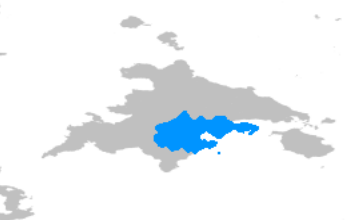Seqoyah
This article is incomplete because it is pending further input from participants, or it is a work-in-progress by one author. Please comment on this article's talk page to share your input, comments and questions. Note: To contribute to this article, you may need to seek help from the author(s) of this page. |
Federal Republic of Seqoyah Seqoyah | |
|---|---|
| Motto: Prosperity | |
| Anthem: The Union Hymm | |
 Seqoyah Parthenia | |
| Capital and largest city | St Francis |
| Official languages | Anglish |
| Recognised regional languages | Eisen, Brinnish |
| Demonym(s) | Seqoyahan |
| Government | Federal parliamentary republic |
• President | Gareth Newton |
• Prime Minister | Nicola De Coq |
| Legislature | National Parliament |
| Federal Council | |
| National Parliament | |
| Population | |
• 2023 estimate | 87,198,480 |
• Density | 97/km2 (251.2/sq mi) |
| GDP (nominal) | 2023 estimate |
• Total | $4,719,120 million (High) |
• Per capita | $54,600 |
| HDI (2020) | 0.977 very high |
| Currency | Seqoyhan Dollar SY$ |
| Calling code | +07 |
| Internet TLD | .sq |
Etymology
The nation of Seqoyah was named after the Hakon indigenous word for the characteristic Giant Redwood Trees which extensively forested the inland areas. A key national symbol the Seqoyah features on the national flag, seal and government logo.
History
Prior to Parthenian discovery and colonisation the area was inhabited by numerous tribal groups which broadly fell into four large ethno-linguastic nations; the Hakon, Chamason, Yaaku, and Penetah.
Colonisation
Following the discovery of Borealis the coastal areas of Seqoyah experienced a steady stream or independent colonists, especially from Angland following the Anglish Civil War. Other colonists included those from Vermand and Brynmor.
The value of the territory now consisting Seqoyah was not considered high. Unimproved land was not productive, the giant Seqoyah tree's were a key source of income, but the nation's mineral wealth had not yet been fully discovered of exploited and as a result did was not officially encompassed into the Battanian Empire, instead maintaining a tacit subservience and loyalty to the emerging 'hyperpower'.
Several independent states were decreed by colonists, which started to form eight states and form a lose union. These included Mynyth (an alternative spelling of the Brynish word for mountain) and the eastern peninsular state of Kalifona.
The Gold Rush of the 1840s led to dramatic change in the nation's demographics and fortunes. The rush brought around 300,000 people from across Eleziar, not just Parthenia. As well as an influx of labour, the rush injected huge amounts of capital into the country which. This was notably spent on railroads which opened up the inland areas and the wholesale improvement of agricultural land and the planting of orchards, vineyards, and cereal fields.
As settlers continued to push inland, they displaced indigenous groups pushing them to the margins. This resulted in a number of small wars and skirmishes. The period is known as the Native Wars.
Federalization
By the 1860's far from being an economic backwater, the now eight states of Seqoyah were valuable and wealthy territories with growing industrious populations. The wealthiest state New Kornkia has began to build institutions including banks, an effective court system and several universities as well a defence forces who had gained experience in the Native Wars.
A risk of invasion and integration into the Battanian Empire was considered the main concern by the late 1880s. Merchants, bankers and industrialists from New Kornkia began to propose nation-hood and unity of the eight states under a single Federal nation.
The 'Seqoyah' was chosen as the national symbol in the first conference of St Francis when New Kornkia, Mynythh and Kalifona unified into a Federation on April the 7th 1870.
Geography
Biodiversity
Politics and Government
Foreign Relations
Military
Administrative Divisions
Law
Law Enforcement
Economy
Primary sector
Secondary sector
Tertiary sector
Quarternary sector
Energy
Transport
Demographics
Urbanization
Immigration
Religion
Languages
Education
Healthcare
Culture
See Also
References
This article is incomplete because it is pending further input from participants, or it is a work-in-progress by one author. Please comment on this article's talk page to share your input, comments and questions. Note: To contribute to this article, you may need to seek help from the author(s) of this page. |
Currently a rump page to help set up overall templates that work on categories. Please do not delete, will be reworked

